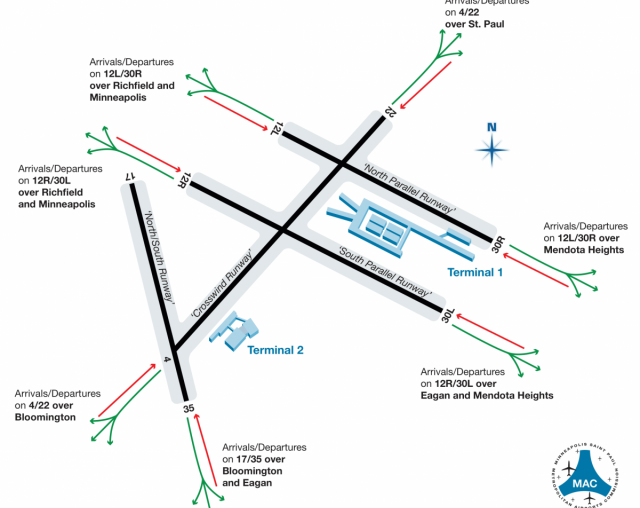✈️ We should hear fewer planes over Longfellow this summer (but more next year)
And a mercifully brief explanation of why.

Note: This story is free for everyone. To access everything else, become a subscriber.
As far as plane noise goes, Longfellow doesn't have it too bad, especially given our proximity to an international airport that handles 400,000 flights a year. While the sound of distant jet engines is commonplace, it’s pretty rare to have to pause a conversation for several beats mid-sentence, in the way our neighbors to the west are used to.
But by the same token, most of us haven't developed the aural callus that longtime Nokomis-dwellers say allows them to "not even hear it anymore." Nor do we have their fancy airport-funded windows. And regardless of quantity, less plane noise is better than more.
So when the Metropolitan Airport Commission (MAC) began a summer-long project of tearing up and rebuilding one of MSP’s main runways last week, I wondered about the brass tacks: Will there be more or fewer planes overhead during construction? And, bigger picture: What exactly determines whether planes fly over the neighborhood or not?
Here’s the gist of what I learned:
Runways: There are four major runways at MSP, three of which can take off in either direction. So, there are basically seven options for runway takeoffs. The two most heavily-used runways during typical weather conditions are the North and South Parallel runways, which are the two that typically send planes over south Minneapolis.

Take-off and landing direction: It's safer for planes to take off and land against the wind. So, wind is the main dictator of which direction a plane takes off or lands, regardless of where it's headed. Accordingly, planes end up taking off over south Minneapolis more commonly when the winds are from the north or west, and descend over the city when winds come from the south or east.
In the Twin Cities, the "prevailing" (or, most common) winds come from the north-northwest in the winter and south-southeast in the summer. Ipso facto: On average, south Minneapolis and surrounding suburbs will get more departure traffic in the winter and more arrival traffic in the summer.
Arrivals versus departures: Take-offs are louder than landings, because more engine power is involved, but descending planes are plenty audible too.
Paths: Since a plane takes off mainly according to the wind, not where its headed, it often has to take sweeping turns to get onto a path towards its destination once in the air. Planes follow a series of predetermined patterns to get in or out of the vicinity of the airport. The planes that end up over Longfellow are typically those that take off westward and then make a sweeping turn to head east (and vice versa for planes landing).
The FAA has been trying to consolidate these routes nationwide, and in the Twin Cities tried to overhaul the routes about 10 years ago but abandoned the effort after major pushback from south Minneapolis, Edina, and Richfield residents; they’re planning to revive that push next year.
Priority: MSP has a pecking order for preferred paths. All things equal, they’d prefer to send planes southeastward over Mendota Heights and Eagan, following a path above primarily industrial areas. The paths over the dense residential areas of South Minneapolis and surrounding suburbs are the least desirable. Of course, all things aren't equal, and prevailing winds end up causing heavy usage of routes over Minneapolis. Plus, the busier the day at the airport, the less discretion controllers have to choose where to send the planes.
Longfellow traffic: Though south Minneapolis as a whole gets plenty of air traffic, most routes don't pass over Longfellow.


Heatmap of take-off (left/top) and arrival (right/bottom) traffic from last month (📸: MAC)
Those that do fly over the neighborhood are mostly from the 30R “North Parallel" Runway. This is the runway that's under construction this summer. As a result, we should hear…
Less plane traffic than usual this summer, but more next year: While the North Parallel Runway is out of commission until September, more traffic will be funneled to the other runways, especially the South Parallel Runway. MAC confirmed that this means we should hear fewer planes on the flight path over Longfellow.
However, the inverse will be true next year when MAC reconstructs MSP's South Parallel Runway and accordingly sends more planes on the 30R Runway that often flies over the neighborhood. This work will take place during two shorter periods: Once in April/May, and again in August/September.
You can learn more about the construction on MAC’s website. Noise complaints go here. And it’s not the most fun to use, but if you want to dig into flight pattern data, you can use this interactive map tool under the “Operations” tab.


